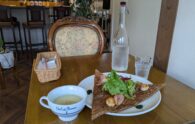As the influence of Covid-19 envelopes the world, many are at home due to lockdowns. Here in Japan, an emergency declaration has been issued by the government asking citizens to refrain from non-essential and non-urgent travel and outings. With uncertainty in the air as to how long the situation will continue, I’m sure the majority of us are making various efforts to keep entertained at home.
In Ichinoseki City, located within the Kitakami site of Japan, we eat ‘mochi’, also known as Japanese rice cakes (not saying that most of us are spending our time eating mochi all day…)! In order to make sure that those coming from abroad aren’t surprised or confused by this food, I’m going to take it upon myself to provide a rundown on mochi before the ILC is realized! Here’s hoping that this article will assist in deepening your understanding of our local specialty and provide some entertainment in the meantime.
Mochi, which is made from ‘mochigome’, a glutinous type of rice, is rather difficult to explain as its unique squidgy, chewy, stretchy texture is unlike anything found in common western cuisine. Mochi began to be consumed in this region around 400 years ago during the Edo era. At the order of the lord of the Date clan who governed the region, it was customary to offer mochi to the gods on the 1st and 15th of every month and pray for peace. However, the poor farmers were unable to eat the proper mochi, and were eating a lower grade type called “Shiina mochi” which is a mixture of rice scraps and unsavory grain. The origin of our flourishing mochi culture came as a result of the efforts of those farmers trying to figure out how to eat ‘shiina mochi’ in more palatable ways. There are now around 300 variations, from traditional to contemporary mochi recipes. Mochi has also been garnering attention since Japanese cuisine was registered as a UNESCO Intangible Cultural Heritage.

A mochi platter

Mochi fondue!
Making mochi begins by pounding steamed glutinous rice with a pestle in a wooden mortar. Water is added and the mochi dough is constantly pounded and turned over until smooth. The process of pounding rice into mochi is called “mochitsuki”. In Ichinoseki, there are several mochitsuki groups that can be called on to perform demonstrations at events. Some of you may recall seeing one at the LCWS2016 banquet in Morioka.

Makin’ mochi

A performance put on by a local mochi-making group

Mochi-making at LCWS 2016
Ichinoseki City has numerous events related to mochi. Some of the larger ones include the ‘Mochi Festival’ where you can try dozens of different types of mochi, ‘Japan’s no.1 Mochi Pounding Contest’ where participating teams are judged on mochitsuki performance, the taste and arrangement of mochi and last but not least, the ‘Wanko Mochi Tournament’, where contestants compete to eat as many bite-sized mochi servings as they can within 5 minutes. So far this year, some events have been canceled due to Covid-19, but normally each of these events pull large crowds of people annually.

The Mochi Festival
Although I’m sure there are places where you can acquire mochi in your own countries or online, when the world overcomes Covid-19, we invite you to come to Ichinoseki for a real mochi making experience and to try some freshly made mochi (on top of checking out the Kitakami site of course…). If you can think of some interesting toppings or recipes to add to the 300 plus that exist to date, we would love to hear about them!
Japanese
~もちのまち「一関」~新型コロナウィルス感染拡大の影響により、海外ではロックダウンにより自宅待機となっているところもあります。ここ日本においても、不要不急の外出を控えるよう、政府による緊急事態宣言が発令されたところです。
いつまで自宅待機が続くのか先が見えない中、楽しく自宅で過ごそうと、さまざま工夫を凝らしているのではないでしょうか。日本の北上サイトに位置する一関市では、餅を食べて過ごします!(多くの市民が餅を食べて過ごしているわけではありません…)
ILC実現後、海外から一関へ来られた皆さんが、餅を目の当たりにし、「このような食べ物があるなんて!」と驚かれないよう、勝手ながら事前レクチャーをさせていただきます!ひまつぶしに、ぜひとも餅について理解を深めていただければ嬉しいです。
餅とは、米の一種である「もち米」をついてできたとても弾力のある食べ物です。この地方で餅が食べられるようになったのは、今から400年ほど前の江戸時代のこと。この地方を治めていた伊達藩のお殿様の命により、毎月1日と15日に神様に餅を供え、平安無事を祈る習慣がありました。しかし、貧しい農民はその餅を食べることができず、くず米と雑穀を混ぜ合わせた「しいな餅」を作って食べていたようです。このしいな餅をおいしく食べたいと工夫をしたことから、独自のもち文化が開花しました。伝統的なもち料理に、アレンジもちなど、今ではそのバリエーションは約300種類にも及びます。「和食」がユネスコ無形文化遺産に登録されて以来、餅も注目を浴びています。
【写真: もち膳】
【写真:もちフォンデュ(アレンジもち)】
餅は、もち米を「つく」ことから始まるのですが、「つく」道具を杵と言います。臼と呼ばれる木でできた大きい器にもち米を入れ、杵でつきます。もち米をひっくり返したり水を加えたりしながら、ついていきます。この一連の動作を「もちつき」と言います。一関には、もちつきの実演を行う出張もちつき隊が複数あります。各種イベントなどで、もちつきパフォーマンスをしてくれます。皆さん覚えていらっしゃいますか?LCWS2016 in 盛岡のバンケットでも、もちつきパフォーマンスをしましたね。
【写真:もちつき】
【写真:もちつき隊によるパフォーマンス】
【写真:LCWS2016in盛岡でのもちつきパフォーマンス】
一関市は餅に関するイベントも豊富です。数十種類の餅が一度に食べられる「もちフェスティバル」、出場チームがもちの味や盛り付け、ダンス等も織り交ぜたもちつきパフォーマンスで競い合う「日本一のもちつき大会」、一口大にカットされた餅を5分で何個食べられるかを競い合う「わんこもち大会」などなど。今年はコロナウィルスの影響で、中止になってしまったイベントもありますが、毎年多くの人で賑わいます。
【写真:もちフェスティバル】
ぜひ一度、この機会に餅を味わってみてはいかがでしょうか。オリジナルのアレンジ餅を開発してみても面白いですね。そして、コロナウィルスが終息した際には、本場の餅つき体験と、つきたての餅を食べに一関市へお越しください!(北上サイトの下見もかねて…)



